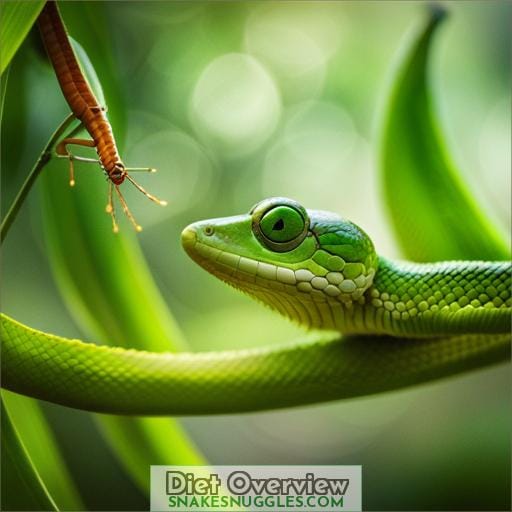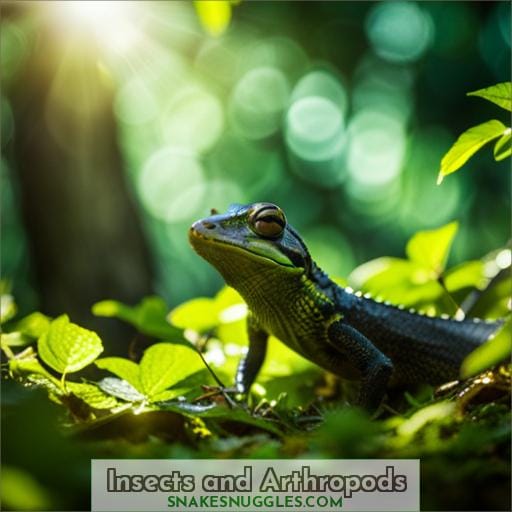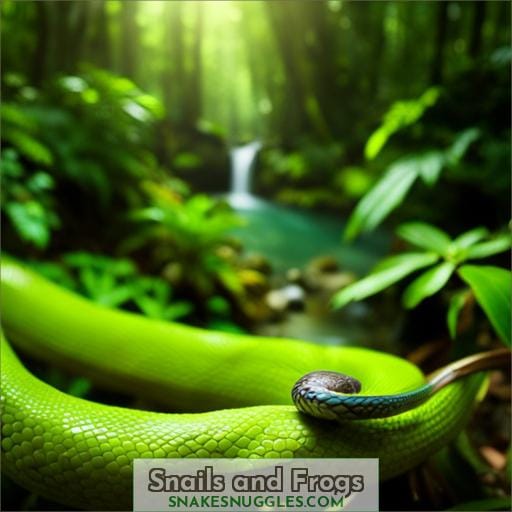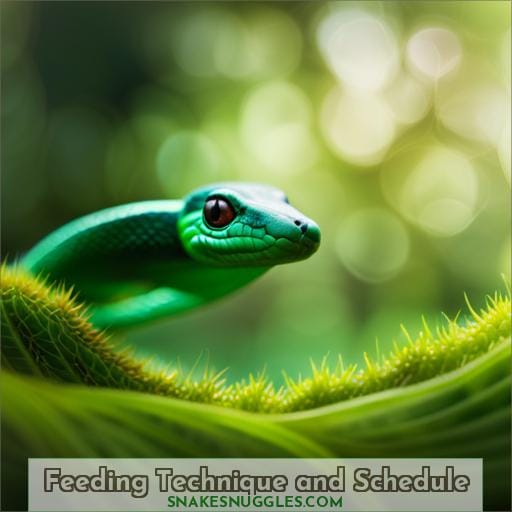This site is supported by our readers. We may earn a commission, at no cost to you, if you purchase through links.
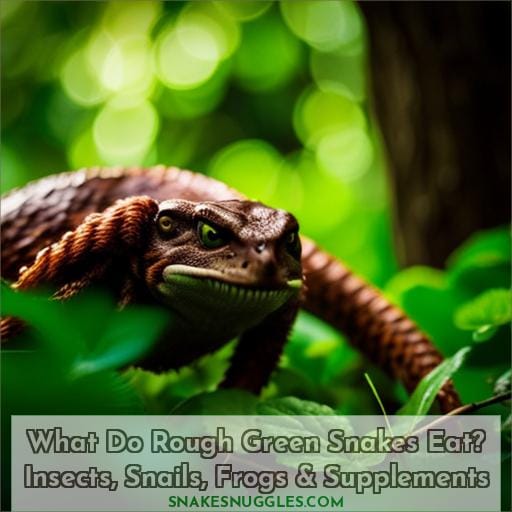
Insects and other terrestrial arthropods form the bulk of their diet, with occasional consumption of snails and tree frogs.
Providing a balanced diet that includes the necessary nutrients is crucial for optimal health and well-being.
Supplementing their diet with essential vitamins and minerals ensures proper growth and development.
Their unique feeding techniques and schedule cater to the specific needs of these intriguing creatures.
Table Of Contents
- Key Takeaways
- Diet Overview
- Insects and Arthropods
- Snails and Frogs
- Supplements
- Feeding Technique and Schedule
- Frequently Asked Questions (FAQs)
- Can I feed my rough green snake mealworms or crickets from the pet store?
- Is it okay if my rough green snake skips a meal or two?
- How often should I give my rough green snake calcium or vitamin supplements?
- What symptoms might I see if my rough green snake has an improper diet?
- Can I feed a rough green snake freshly killed prey or does it need to be live?
- Conclusion
Key Takeaways
- Primarily eat insects and arthropods like crickets, grasshoppers, caterpillars, and beetles
- Occasionally prey upon tree frogs, baby mice, or snails to add variety and nutrients
- Need calcium and vitamin supplements added to feeder insects for proper bone health
- Feeding schedule varies by age; babies/juveniles every 5-7 days, adults weekly
Diet Overview
When keeping rough green snakes as pets, you’ll be feeding them a diet consisting primarily of insects and arthropods to meet their nutritional needs.
As carnivores that hunt by sight, rough green snakes have adapted to catch fast-moving insects and other small prey.
Their preferred foods include crickets, grasshoppers, caterpillars, and beetles, which they’ll readily accept in captivity.
It’s important to provide a variety of appropriately sized feeder insects to satisfy their nutritional requirements.
Supplementing their diet with an occasional tree frog or baby mouse also provides enrichment.
Maintaining proper temperatures and habitat that enables natural hunting behaviors supports their overall health.
Providing adequate climbing branches and foliage densifies their environment, promoting activity.
Insects and Arthropods
Because of their insectivorous nature, you’re feeding your rough green snake a diet consisting primarily of insects and other arthropods.
Crickets, mealworms, waxworms, and cockroaches should make up the bulk of the diet.
Try to provide a variety of sizes and species to mimic the diversity of prey they’d consume in the wild.
Dust insects with calcium and vitamin supplements at every other feeding for optimal nutrition.
Always gut load feeder insects with nutritious foods like fruits and vegetables for at least 24 hours prior to feeding them to your snake.
Monitor the prey size and only offer items no wider than the widest part of the snake’s head.
Snails and Frogs
In addition to insects and arthropods, rough green snakes will occasionally prey upon snails and tree frogs.
Though small, these snakes have adapted to handling the shells of land snails and extracting the soft body within. Their slender jaws allow them to consume several species of tree frogs, including gray tree frogs, green tree frogs, and barking tree frogs.
This occasional amphibian consumption provides dietary variety and nutrients that purely insectivorous fare may lack.
By branching out to take advantage of additional food sources like snails and frogs when the opportunity arises, rough green snakes broaden their ability to thrive across the range of habitats they occupy.
Supplements
You’ll often need to supplement your rough green snake’s diet with calcium and vitamin powders.
These supplements help ensure proper bone development and overall health.
Use calcium supplements without vitamin D3 2-3 times per week.
Use a multivitamin once per week.
Use vitamin supplements sparingly, as oversupplementation can cause health issues.
When handling supplements, carefully follow manufacturer’s instructions regarding dosage.
Mix supplements into prey items for easier administration and absorption.
Proper supplementation supports skeletal structure, immune function, digestion, and disease resistance in rough green snakes.
Monitoring your snake’s health and regularly consulting an exotic veterinarian allows for adjustments as needed.
Feeding Technique and Schedule
Supplementation is crucial, yet proper feeding technique ensures your snake thrives.
Determine appropriate prey size and offer meals no larger than the thickest part of its body.
Feed babies and juveniles every 5-7 days, while adults only require weekly feedings.
Vary diet using insects and small vertebrates.
Offer food in the evening when snakes are most active.
Use long forceps, never fingers, when introducing prey.
Monitor eating, provide hides, and leave snakes undisturbed while feeding.
As urbanization destroys habitats, educating others on ideal husbandry promotes conservation, protecting the rough green snake‘s niche.
With proper care, your pet connects you to nature, fulfilling innate needs for purpose.
Frequently Asked Questions (FAQs)
Can I feed my rough green snake mealworms or crickets from the pet store?
No, mealworms and crickets lack key nutrients rough green snakes need.
Offer small, soft-bodied insects and invertebrates instead to meet their insectivorous needs.
Vary offerings as much as possible for complete nutrition.
Is it okay if my rough green snake skips a meal or two?
Yes, it’s normal for green snakes to skip meals occasionally.
Offer food again in a few days.
Monitor their weight and health.
Consult an exotic veterinarian if appetite loss persists beyond a week or two.
How often should I give my rough green snake calcium or vitamin supplements?
Supplement calcium weekly and vitamins twice a month.
This provides essential nutrients that whole-prey diets lack.
Calcium supports bone health.
Vitamin deficiencies cause issues.
Offer supplements by dusting prey items prior to feeding.
What symptoms might I see if my rough green snake has an improper diet?
Loss of appetite, lethargy, weakness, weight loss, constipation, or diarrhea could signal an imbalanced or improper diet.
Ensure prey items match native foods, offer appropriate supplements, and monitor closely after changes.
Consulting an experienced herpetologist can help adjust diet components for ideal health.
Can I feed a rough green snake freshly killed prey or does it need to be live?
Green snakes can be offered freshly killed prey,
but live insects tend to trigger their natural hunting instincts best.
Gently wiggling mealworms, crickets, or cockroaches near their enclosure often elicits enthusiastic strikes.
Live prey satisfies nutritional and behavioral needs.
Conclusion
Through their unique adaptations, rough green snakes reveal nature’s artistry.
As terrestrial arthropods scuttle amidst the leaf litter, a rough green snake may dart out, relying on exceptional eyesight to snatch its next meal.
By understanding the dietary needs of these harmless serpents, we better appreciate the interconnectedness of all forest dwellers working together, each with its own role to play.

